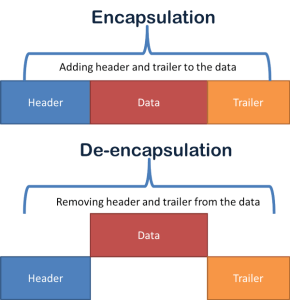Encapsulation and Decapsulation Processes
Lesson Objectives
By the end of this lesson, you will:
- Understand the concepts of encapsulation and decapsulation in networking.
- Learn how data flows through the layers of the OSI and TCP/IP models.
- Explore real-world examples of encapsulation and decapsulation during data transmission.
Introduction: Packaging and Unpacking Data
When you send a letter, it is packaged in an envelope, labeled with the recipient’s address, and passed through a series of delivery steps. Networking follows a similar process: data is encapsulated (packaged) with necessary headers at each layer before transmission and decapsulated (unpackaged) upon reception.
In this chapter, we’ll explore the encapsulation and decapsulation processes in detail, understanding how they ensure reliable communication between devices.
What is Encapsulation?
Encapsulation is the process of adding headers (and sometimes trailers) to data as it moves down through the layers of the OSI or TCP/IP model. Each layer adds specific information required for successful transmission.
Steps in Encapsulation:
- Application Layer:
- Data is created and formatted for the application (e.g., an email in SMTP or a web request in HTTP).
- Transport Layer:
- Segments the data for transmission.
- Adds headers for reliable delivery (e.g., TCP sequence numbers).
- Network Layer:
- Adds source and destination IP addresses to create packets.
- Data Link Layer:
- Frames the packets by adding MAC addresses and error-checking information.
- Physical Layer:
- Converts frames into bits (0s and 1s) and transmits them over the medium.
What is Decapsulation?
Decapsulation is the reverse of encapsulation. As data is received, it moves up the layers of the model, with each layer removing its respective header and processing the data.
Steps in Decapsulation:
- Physical Layer:
- Receives bits and converts them into frames.
- Data Link Layer:
- Verifies the frame’s integrity and extracts the packet.
- Network Layer:
- Reads the IP addresses and forwards the segment to the appropriate transport layer.
- Transport Layer:
- Ensures all data segments are received and reassembles them into complete messages.
- Application Layer:
- Delivers the data to the application (e.g., displaying a webpage or email).
Real-World Example: Sending a Web Request
Scenario: You want to access a webpage at www.example.com.
Encapsulation Process:
- Application Layer (HTTP):
- The browser sends an HTTP GET request for the webpage.
- Transport Layer (TCP):
- TCP segments the request and adds headers with port numbers and sequence numbers.
- Network Layer (IP):
- IP adds source (your device) and destination (web server) IP addresses to create packets.
- Data Link Layer (Ethernet):
- Ethernet adds source and destination MAC addresses to create frames.
- Physical Layer:
- Converts frames into electrical signals or wireless waves and transmits them.
Decapsulation Process (on the web server):
- Physical Layer:
- Receives the signals and converts them back into frames.
- Data Link Layer (Ethernet):
- Verifies the frame’s integrity and extracts the IP packet.
- Network Layer (IP):
- Checks the destination IP address and passes the segment to TCP.
- Transport Layer (TCP):
- Reassembles the segments into the original HTTP request.
- Application Layer (HTTP):
- Processes the HTTP request and sends the webpage data back to your browser.
Visualizing Encapsulation and Decapsulation
| Layer | Encapsulation (Sender) | Decapsulation (Receiver) |
|---|---|---|
| Application | Create data (e.g., HTTP request) | Process data (e.g., HTTP response) |
| Transport | Add TCP/UDP headers | Remove TCP/UDP headers |
| Network | Add IP headers | Remove IP headers |
| Data Link | Add MAC addresses, error checking info | Remove MAC addresses, verify frame |
| Physical | Convert to bits | Convert back to frames |

Headers and Their Roles
1. Application Layer:
- Defines the type of data (e.g., HTTP request, email).
2. Transport Layer (TCP/UDP):
- Ensures reliability and order of data delivery.
- Example: TCP headers include sequence numbers to reassemble packets in the correct order.
3. Network Layer (IP):
- Provides addressing for routing.
- Example: IP headers include source and destination IP addresses.
4. Data Link Layer (Ethernet):
- Manages physical addressing and error checking.
- Example: Ethernet frames include MAC addresses and checksums.
Key Takeaways
- Encapsulation: Adds headers and trailers to ensure successful data delivery.
- Decapsulation: Strips headers to deliver data to the intended application.
- Layered Communication: Each layer focuses on a specific function, ensuring modular and efficient data handling.
Activity: Analyze a Packet with Wireshark
- Open Wireshark and capture packets on your network.
- Inspect a packet and identify the headers for each layer (e.g., Ethernet, IP, TCP).
- Match the headers to their respective layers in the OSI or TCP/IP model.
Reflection: Why Are These Processes Important?
Encapsulation and decapsulation ensure that data can travel across networks reliably and reach its intended destination. Understanding these processes is essential for troubleshooting and designing efficient networks.
What’s Next?
In the next chapter, we’ll dive deeper into Layer Functions, exploring the specific responsibilities of each layer in the OSI and TCP/IP models.
Your knowledge of data flow is advancing—let’s keep building! 🚀
